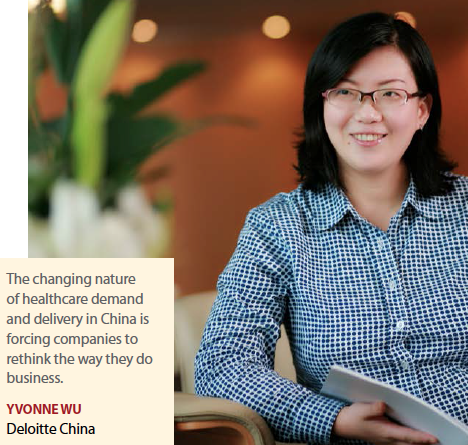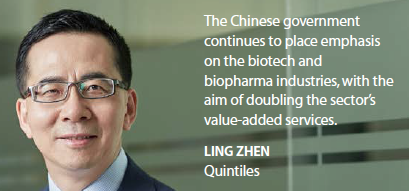 Over the past 25 years, China has been on an extraordinary economic trajectory. Economic and political reforms that were implemented in the latter part of the last century have transformed the country.
Over the past 25 years, China has been on an extraordinary economic trajectory. Economic and political reforms that were implemented in the latter part of the last century have transformed the country.
“The result is the emergence of a new economic and political super power with global GDP performance second only to that of the United States," says Ling Zhen, Quintiles general manager of greater China.
To ensure further sustainable growth, Mr. Zhen says the Chinese government is continuing its transformation from a manufacturing-driven economy — i.e. “Made in China" — to an innovation-driven economy — i.e. “Innovated in China." As part of this transformation, the pharmaceutical industry has been identified as a critical innovation sector in which billions of dollars have been invested by various government bodies and agencies, with additional support through policy and economic incentives.
Market Opportunities
The Chinese government has made significant multi-pronged investments to grow the local R&D industry, says Yvonne Wu, managing partner, life sciences and healthcare industry, Deloitte China.
“The aggregate result is increased local R&D output, a more innovative R&D pipeline, and China’s growing importance in support of global and regional study submissions," Ms. Wu says.
According to the statistics by the Center for Drug Evaluation at China Food and Drug Administration, the R&D pipeline application in 2014 was 7,829, an increase of 33% compared with 2011.
 In spite of a recent economic slowdown, the Chinese government has not shown any sign of reducing investment and is still firmly committed to accelerating the transformation of the healthcare industry and pharmaceutical sector as a whole, Mr. Zhen says.
In spite of a recent economic slowdown, the Chinese government has not shown any sign of reducing investment and is still firmly committed to accelerating the transformation of the healthcare industry and pharmaceutical sector as a whole, Mr. Zhen says.
“The healthcare industry in China remains healthy, driven by the aging population, urbanization, increasing wealth, and the government’s commitment to spending more on healthcare, which will help bring China more in line with other developed and developing markets," says Adele Li, commercial director for Kantar Health China. “Penetration by multinational corporations is expected to lead the way for the innovative pharma industry in China."
The scale of operations is also growing, with Mr. Zhen noting that more than 40 multinational pharmaceutical companies have set up commercial and/or R&D hubs in China, in many cases rivaling the scale of their counterparts in the United States and Europe.
“These investments by multinational pharmaceutical companies have further accelerated the shift of innovative R&D projects and talent from the West to China," he says.
Addressing unmet needs specific to Chinese patients is a key lever for expediting the CFDA approval process, Ms. Wu notes.
“For many under-represented but rapidly growing therapeutic areas, such as liver and gastric cancers, there is strong rationale for fast-track qualification if superior clinical results from mainland China, backed up by data from Asian populations in global trials, can be demonstrated," she notes.
After 10 years of “super" growth, China’s life-sciences sector has reached a turning point where multinational companies’ traditional business models are showing limitations, Ms. Wu notes.
“The changing nature of healthcare demand and delivery in China is forcing companies to rethink the way they do business, particularly if they wish to continue their trajectory of rapid growth and expansion," she says. “Companies need to examine their existing assets, capabilities, and product portfolios and determine how to better adapt to local policy requirements, meet local healthcare needs, develop partnerships to improve market penetration, and maximize the value of their investments."
Ms. Li notes that China’s drug innovation has a lot of challenges, adding that learning how to foster an innovation ecosystem calls for changes in mindset.
Mr. Zhen says given the government’s initiatives favor companies with strong R&D capabilities, global companies are encouraged to introduce innovative products to China as quickly as possible.
“Companies with streamlined R&D and market access capabilities will be a step ahead of their competitors," he says. “In addition, as the government proactively works to reduce healthcare expenses and closely monitors compliance, some global companies are actively transitioning to evidence-based, scientific-driven sales models. This may bring opportunities for more real-world late-phase studies."
Another avenue companies are exploring is to form partnerships with Chinese pharmaceutical companies.
 “These partnerships with local players have allowed global companies to leverage local know-how and expertise from their local partners to accelerate growth and reduce their development and commercial risks in China," Mr. Zhen says.
“These partnerships with local players have allowed global companies to leverage local know-how and expertise from their local partners to accelerate growth and reduce their development and commercial risks in China," Mr. Zhen says.
Healthcare Dynamics
Growth opportunities for pharmaceutical companies in China are strongly intertwined with dynamics shaping the delivery of healthcare services generally.
A rapidly aging population, increasing urbanization and westernization of lifestyles, and increasing wealth have resulted a shift in the type of care required, Ms. Wu says. In response, the government has been working to reshape care delivery.
“The government has moved to establish a viable primary care network, thus encouraging private healthcare while at the same time restraining the healthcare expenditure growth through innovative cost-control mechanisms," she says.
In 2009, the government started an ambitious reform program to expand access, increase affordability, and improve quality of care, Ms. Wu says.
Two major forces have been driving the evolution of China’s healthcare sector, Ms. Wu says.
One force is the rising demand for healthcare services such as aging population, rising average income, increasing urbanization, and changing of lifestyles.
The second is expanded supply of healthcare services such as development of primary care, expansion of private health, and improving affordability.
 “These two forces have been impacting the healthcare system in China for quite a long time, which resulted in healthcare reform in 2009," she says. “During the second and third phases of healthcare reform, we do see China shifting its focus from increasing healthcare service volume to enhancing provision efficiency.
“These two forces have been impacting the healthcare system in China for quite a long time, which resulted in healthcare reform in 2009," she says. “During the second and third phases of healthcare reform, we do see China shifting its focus from increasing healthcare service volume to enhancing provision efficiency.
“As a result, the government is initiating programs to promote a tiered healthcare system, reduce unnecessary drug usage, reform public hospitals, and channel private capital into healthcare provision and health insurance," Ms. Wu continues.
“Another force is the emergence of new technologies and care models such as mHealth and wearable devices, which are changing how care is provided."
Ms. Li notes that in March 2015, the state council issued the National Healthcare Institution Development Outline (2015-2020), specifying the development target of primary healthcare institutions by 2020. In September 2015, the state council issued guidance on the tiered healthcare service system, which lays out the two-way referral in detail.
She explains that China has different layers of healthcare services providers. At the bottom, there are community healthcare centers (8,669) and township healthcare stations (37,497); in the middle are county and district hospitals (6,850); and at the top are tier III hospitals.
Patients have the freedom to choose their favorite hospitals to access, so in the big city tier III hospitals are always very crowded.
Therefore, the government wants to encourage hierarchical referrals and two-way patient referrals to manage the patient flow.
“The 13th five-year plan reconfirmed the national strategy to push healthcare resources to lower-tier hospitals," Ms. Li says. “As the China healthcare landscape is shifting, a lot of stakeholders need to adjust their strategies to adapt to these dynamics. Global companies should focus on supporting lower-tier hospitals to adapt to the changing environment."
Ms. Li says county hospitals will become an increasingly important market for the pharmaceutical industry.
“The government is increasing its investment in new infrastructure and physician training and is adopting reimbursement policies to encourage people to go to county facilities instead of big city hospitals," she says.
Risk and Reward
According to Ms. Li, ongoing healthcare reform places increased emphasis on cost-containment, which could present challenges for multinational pharmaceutical companies.
The key areas of focus are to lower drug prices, with authorities primarily looking at generic and off-patent drugs; expand the essential-drug list (EDL) and replace high-priced products with lower-cost EDL drugs; lower the price of drugs on the reimbursement drug list, potentially reducing off-patent drugs to a maximum of 30% over local generics; introduce stricter price granting for off-patent drugs; and intensify the tendering process within each province.
Ms. Wu says as China’s market access system continues to evolve, companies will need to adapt their national and local market access strategies to achieve win-win outcomes with the government and other payers.
In addition, Ms. Wu says to date success in top-tier cities like Beijing and Shanghai has been the primary revenue driver for most multinational pharmaceutical companies operating in China, noting that most multinational companies focus primarily on tier 1 and 2 cities.
“While the promise of this segment has been well-documented, to date, few companies have successfully entered the lower-tier market because most have sought to recreate high-cost models better suited to developed healthcare markets," she says.
Another key consideration for companies will be partnering with private healthcare providers to pilot physician or patient care programs, or to gather outcomes data about products or services.
“China does not prevent pharmaceutical firms entering healthcare provision," Ms. Wu says. “Opening diabetes clinics, oncology centers or health check-ups could be a lucrative revenue source."
The other major change that companies will need to consider for future success is to rethink their existing high-cost, high-touch, sales rep-supported model and move toward an approach that is balanced across functions.
“Moving forward, the market will demand balanced, scientifically driven dialogue that is supported by practical, real-world evidence in China," Ms. Wu says. “Companies will have to adapt their customer model to reflect new realities."
Regulatory and Clinical Environment
China has proven to be fertile ground for clinical research for both multinational and domestic pharmaceutical companies in recent years, Mr. Zhen says. A number of factors have contributed to China’s attraction as a key destination for clinical development.
Firstly, China’s large, aging population and diversity in diseases creates an attractive clinical environment, he says.
Other benefits include continuing investment by both global CROs and local CROs in China, which have resulted in a greater number of full-service CROs staffed by properly trained, clinical research professionals.
“As these CROs become more involved in varied clinical trials at global, regional, and local levels, they are gaining well-rounded experience to handle critical issues that arise in clinical trials of varying complexity," Mr. Zhen says.
Ms. Wu says local CROs are creating opportunities for R&D partnership.
“While many partnerships with CROs are short term and project-based, Wuxi Pharmatech built a dedicated facility for its partnership with BMS to support development of small molecule entities more long term," she says.
Stricter inspection of study sites also helps to address any concerns.
“With increasing exposure to various global and regional studies, both sites and investigators have gained greater mastery of ICH GCP and are able to address typical issues involved in clinical trials," Mr. Zhen says.
The other critical point in helping to improve the clinical trial environment is the fact the CFDA recently launched a series of initiatives to update regulations and streamline regulatory review/approval processes. Mr. Zhen notes that these initiatives have resulted in increased transparency, improved review quality, reduced wait time, and higher standard requirements for clinical development.
“CFDA also launched an aggressive campaign to improve the clinical data quality for clinical trials," he says. “It requested applicants in more than 1,600 pending product approvals to conduct self-audits, including 171 products from multinational drug firms. As of March 2016, more than 80% of applications had been voluntarily withdrawn or rejected by the CFDA."
“Regulatory reforms are leading to higher standard requirements for clinical development, benefiting well-established CROs and pharma companies with solid clinical development teams," he says.
Overall, China has strengthened regulatory controls, experts say. Recently, the CFDA launched a series of new regulations to improve the quality of reviews, increase transparency, and streamline the overall review system. It also committed to resolve a backlog of about 19,000 product registration applications and to provide a fast-track approval system for critical medical needs, Mr. Zhen says.
Regulators introduced new policies to improve the quality of generic drugs and encourage new drug research and innovation. (PV)

















